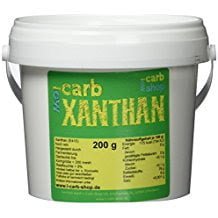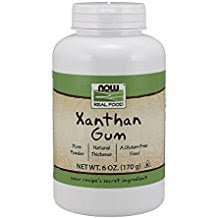Xanthan gum (/ˈzænθən/) is a polysaccharide with a wide variety of uses, including as a common food additive. It is a powerful thickening agent, and also has uses as a stabilizer to prevent ingredients from separating.
It can be produced from a range of simple sugars using a fermentation process, and derives its name from the strain of bacteria used in this: Xanthomonas campestris.
Xanthan gum was discovered by Allene Rosalind Jeanes and her research team at the United States Department of Agriculture, and brought into commercial production under the trade name Kelzan in the early 1960s. It was approved for use in foods in 1968 and is accepted as a safe food additive in the USA, Canada, Europe, and many other countries, with E number E415.
Xanthan gum derives its name from the strain of bacteria used during the fermentation process, Xanthomonas campestris. This is the same bacterium responsible for causing black rot to form on broccoli, cauliflower, and other leafy vegetables.
Xanthan gum, 1%, can produce a significant increase in the viscosity of a liquid.
In foods, xanthan gum is common in salad dressings and sauces. It helps to prevent oil separation by stabilizing the emulsion, although it is not an emulsifier. Xanthan gum also helps suspend solid particles, such as spices.

Xanthan gum helps create the desired texture in many ice creams. Toothpaste often contains xanthan gum as a binder to keep the product uniform.
Xanthan gum also helps thicken commercial egg substitutes made from egg whites, to replace the fat and emulsifiers found in yolks. It is also a preferred method of thickening liquids for those with swallowing disorders, since it does not change the color or flavor of foods or beverages at typical use levels.
In gluten-free baking xanthan gum is used to give the dough or batter the stickiness that would otherwise be achieved with gluten.
In most foods, it is used at concentrations of 0.5% or less.
In the oil industry, xanthan gum is used in large quantities to thicken drilling mud.
These fluids serve to carry the solids cut by the drilling bit back to the surface. Xanthan gum provides great "low end" rheology. When the circulation stops, the solids still remain suspended in the drilling fluid. The widespread use of horizontal drilling and the demand for good control of drilled solids has led to its expanded use.

It has also been added to concrete poured underwater, to increase its viscosity and prevent washout.
In cosmetics, xanthan gum is used to prepare water gels, usually in conjunction with bentonite clays. It is also used in oil-in-water emulsions to help stabilize the oil droplets against coalescence. It has some skin hydrating properties. Xanthan gum is a common ingredient in fake blood recipes, and in gunge/slime.














